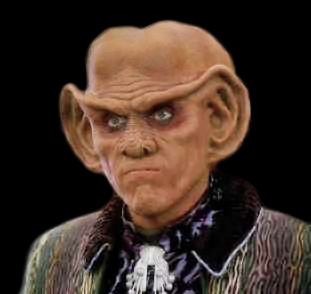
Quark is a fictional character in the American television series Star Trek: Deep Space Nine. He was played by Armin Shimerman and is a member of the extraterrestrial race known as the Ferengi, who are stereotypically capitalist and motivated only by profit.

Benjamin Lafayette Sisko is a fictional character in the Star Trek franchise portrayed by Avery Brooks. He was the main character of the television series Star Trek: Deep Space Nine (DS9), which was originally broadcast between 1993 and 1999. The character has also appeared in various books, comics, and video games within the Star Trek franchise.

Vic Fontaine is a fictional character who appeared in the sixth and seventh seasons of the American science fiction television series Star Trek: Deep Space Nine. Portrayed by James Darren, he is a holographic representation of a 1960s-era Las Vegas Rat Pack–style singer and entertainer, as part of a program run in the holosuites at Quark's bar. The character was developed from an idea by executive producer Ira Steven Behr, who had sought to introduce a character of that type during the fourth season to be played by Frank Sinatra, Jr. After Sinatra turned down the role, it was considered during the following season, to be played by Steve Lawrence, but once again was not used. Darren landed the role after Behr met him at a memorabilia show in North Hollywood and had him invited to audition.
"Emissary" is the series premiere of the American science fiction television series Star Trek: Deep Space Nine. It was aired as a single two-hour episode on its initial broadcast, but was divided into two one-hour episodes when it aired in reruns.
"Melora" is the 26th episode of the American syndicated science fiction television series Star Trek: Deep Space Nine, the sixth episode of the second season.
"The Search" is the 47th and 48th episode of the science fiction television show Star Trek: Deep Space Nine.
"Facets" is the 71st episode of the American syndicated science fiction television series Star Trek: Deep Space Nine, the 25th and penultimate episode of the third season, originally airing June 12, 1995.
"A Man Alone" is the fourth episode of the American science fiction television series Star Trek: Deep Space Nine.
"Invasive Procedures" is the 24th episode of the American syndicated science fiction television series Star Trek: Deep Space Nine. It is the fourth episode of the second season.
"Dramatis Personae" is the 18th episode of the first season of the American syndicated science fiction television series Star Trek: Deep Space Nine.
"Dax" is the eighth episode of the American science fiction television series Star Trek: Deep Space Nine.
"Playing God" is the 37th episode of the science fiction television series Star Trek: Deep Space Nine. It is the 17th episode of the second season. "Playing God" aired on syndicated television starting on February 26, 1994.

"Starship Down" is the 79th episode of the science fiction television series Star Trek: Deep Space Nine, the sixth episode of the fourth season.
"Image in the Sand" is the 151st episode of the television series Star Trek: Deep Space Nine, the opening episode for the series' seventh and final season. It was first aired the week of September 28, 1998.
"Equilibrium" is the 50th episode of the television series Star Trek: Deep Space Nine, the fourth episode of the third season.
"Fascination" is the tenth episode of season three of Star Trek: Deep Space Nine, the 56th episode overall.
"Tears of the Prophets" is the 26th and final episode of the sixth season of the American science fiction television series Star Trek: Deep Space Nine, the 150th episode overall. It was first broadcast in broadcast syndication in the United States the week of June 15, 1998. It was written by Ira Steven Behr and Hans Beimler, and directed by Allan Kroeker. The episode featured the death of the character Jadzia Dax and the final appearance on the series of actress Terry Farrell.
"Shadows and Symbols" is the second episode of the seventh season of Star Trek: Deep Space Nine, the 152nd overall, premiering the week of October 5, 1998. The episode's premiere received Nielsen ratings of 4.2 points corresponding to over 4.1 million viewers. This episode was written by Ira Steven Behr and Hans Beimler, and directed by Allan Kroeker.
"The Jem'Hadar" is the 26th and final episode in the second season of the syndicated American science fiction television series Star Trek: Deep Space Nine, the 46th episode overall. It introduces the Jem'Hadar and the Vorta, two species of the Dominion. It is the last episode to regularly feature the 2360s communicator badge from Star Trek: The Next Generation.



